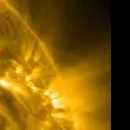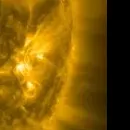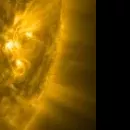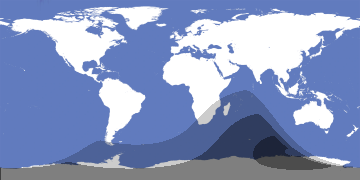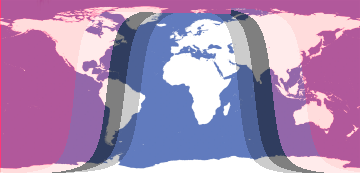Solar Spectrum: Rise, Set, and Space Weather
Sun Events Timetable
| Sunset/Sunrise | 14:55 | 05:22 | ||||||
| Civil Twighlight | 15:26 | 04:52 | ||||||
| Nautical Twighlight | 15:59 | 04:19 | ||||||
| Astronomical Night | 16:31 | 03:47 |
| Elevation at transit | 29° |
| Transit time | 10:09 |
| Distance to Earth | 0.98345 AU (147,122,026 km) |
Sun
 Last update: Sat, 27 December 2025, 19:00
Last update: Sat, 27 December 2025, 19:00
Current Sunspot and Flare Activity
The Sun currently displays 8 active sunspot regions visible from Earth, varying in size and magnetic complexity. This includes 3 newly detected sunspot regions (4324, 4325, 4323) in the past 24 hours.The largest sunspot is AR 4321, classified as Dkc, covering 380 millionths of the solar hemisphere (MSH), and containing 17 individual spots.
No significant flares detected today. All data are current as of Sat, 27 December 2025 19:00, reflecting ongoing real-time monitoring of solar surface activity and flare emissions.
Recent Sunspots
4324
Sunspot Region
AR 4324 is an Dac-class sunspot group that emerged on 2025-12-26 10:31. It covers 130 millionths of the solar disk and contains 5 individual spots.
4325
Sunspot Region
AR 4325 is an Dao-class sunspot group that emerged on 2025-12-27 05:55. It covers 100 millionths of the solar disk and contains 8 individual spots.
4323
Sunspot Region
AR 4323 is an Hax-class sunspot group that emerged on 2025-12-26 06:30. It covers 20 millionths of the solar disk and contains 1 spot.
Explore detailed sunspot data, including all active regions, classifications, and flare history
Real-Time Solar Imaging
The data used in these images are provided by the Solar Dynamics Observatory (SDO). The SDO is a mission of NASA’s Living With a Star (LWS) Program, designed to understand the causes of solar variability and its impacts on Earth. The Atmospheric Imaging Assembly (AIA) and Helioseismic and Magnetic Imager (HMI) instruments onboard SDO deliver high-resolution, real-time images of the sun in multiple wavelengths, which are essential for studying solar phenomena and predicting space weather. We gratefully acknowledge the efforts of the entire SDO team and NASA for making these invaluable data available to the public.
Magnetogram

HMI (Helioseismic and Magnetic Imager) magnetogram photos depict the sun's magnetic field strength and direction on its surface. These images, taken by the HMI instrument on the Solar Dynamics Observatory (SDO) satellite, reveal the intricate magnetic structures, including sunspots and active regions.
Intensitygram

HMI intensitygram photos display the sun's surface in visible light, highlighting features such as sunspots, granulation, and solar faculae. These images, captured by the HMI instrument aboard the Solar Dynamics Observatory (SDO), provide a detailed view of the sun's photosphere, allowing for the observation of sunspot development and movement.
Solar Magnetism: Coronal Loop Dynamics

These photos capture the sun in the 171 angstrom wavelength, highlighting the solar corona and upper transition region. These images, taken by the Atmospheric Imaging Assembly (AIA) on the Solar Dynamics Observatory (SDO), reveal the structure of the sun's outer atmosphere and trace the magnetic field lines extending into space. The 171 Å wavelength is particularly effective at showing the million-degree plasma loops that emerge from the sun's surface.
Active Regions, Flares, and Coronal Holes

AIA 193 Å photos capture the sun in the 193 angstrom wavelength, focusing on both the hot corona and the cooler material of solar flares and coronal mass ejections (CMEs). These images reveal the sun's outer atmosphere and coronal holes, which are regions where the solar wind escapes into space. The 193 Å wavelength is particularly useful for observing the high-temperature plasma that forms in the corona, typically around 1.25 million Kelvin, and during solar flares, it can reach up to 20 million Kelvin.
Solar Passage Through Day
Double-click to unlock the map.
Current Sun position
| Time | 19:34 |
| Latitude | 37.3541 |
| Longitude | -121.955 |
| Sun elevation | -54° |
| Sun Azimuth | 78° |
Yearly Sunlight Dynamics
Sun Properties
| Date | Sun, 28 December 2025 |
| Twiglight begin | 15:59 |
| Twiglight end | 04:19 |
| Astrosession duration | 12h 20m |
| Elevation at transit | 29° |
| Transit time | 10:09 |
| Distance to Earth | 0.98345 AU (147,122,026 km) |
| Equatorial coordinates at midnight | RA: 18h 29m 18s", Dec: -23° 16' 01s |
| Constellation | Sagittarius |
Last and Upcoming Solar Eclipse
Sun, 21 September 2025
Partial Solar Eclipse
| Global | From Your location | |
|---|---|---|
| Penumbra | 07:31-11:55 | Not Visible |
| Umbra | - | Not Visible |
Tue, 17 February 2026
Hybrid Solar Eclipse
| Global | From Your location | |
|---|---|---|
| Penumbra | 23:58-04:28 | Not Visible |
| Umbra | 01:43-02:44 | Not Visible |
Last and Upcoming Lunar Eclipse
Sun, 7 September 2025
Total Lunar Eclipse
| Global | From Your location | ||
|---|---|---|---|
| Penumbral | 05:30-10:56 | Not Visible | |
| Partial | 06:28-09:59 | Not Visible | |
| Total | 07:32-08:54 | Not Visible |
Tue, 3 March 2026
Total Lunar Eclipse
| Global | From Your location | ||
|---|---|---|---|
| Penumbral | 22:46-04:24 | 22:46-04:24 | |
| Partial | 23:51-03:19 | 23:51-03:18 | |
| Total | 01:05-02:04 | 01:05-02:04 |
Aurora Activity
KP-index: 2.67. Slight auroral activity at high latitudes
Aurora Probabilty on Your Location: 0%
Astrometric & Physical Parameters of Sun
Coordinates & Visibility
| Right Ascension | 18.48855° |
| Declination | -23.26706° |
| Magnitude | -26.8 |
| Constellation | Sagittarius |
| Elevation | -54.1° |
| Azimuth | 78° |
Basic Properties
| Mass, kg | 1.98841E+30 |
| Mean density, g/cm³ | 1.408 |
Rotation
| Sidereal rotation period, days | 25.38 d |
Surface & Atmosphere
| Surface gravity, m/s² | 274.0 m/s^2 |
| Escape velocity, km/s | 617.7 |
| Mean temperature, K | 5772 |
Data Acknowledgment
Our solar system data—including planetary physical and orbital parameters—comes from the Solar System OpenData API , maintained by Le Système Solaire. We thank Christophe and the contributors for making this open data available.

